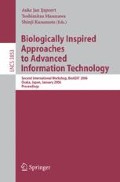Abstract
Traditionally, in robotics, artificial intelligence, and neuroscience, there has been a focus on the study of the control or the neural system itself. Recently there has been an increasing interest into the notion of embodiment not only in robotics and artificial intelligence, but also in the neurosciences, psychology, and philosophy. In this paper, we introduce the notion of morphological computation and demonstrate how it can be exploited on the one hand for designing intelligent, adaptive robotic systems, and on the other for understanding natural systems. While embodiment has often been used in its trivial meaning, i.e. "intelligence requires a body", the concept has deeper and more important implications, concerned with the relation between physical and information (neural, control) processes. Behavior is not the result of brain processes only, but there is a "task distribution" among brain processes (control), morphology, and materials. For example, the positioning of the sensors on the agent, the particular morphology (the anatomy), and the material properties of the muscle-tendon system (the biomechanical constraints) can be exploited for generating adaptive behavior. Morphological computation is about connecting brain, body, and environment (e.g. Pfeifer, et al., 2005, Pfeifer and Gomez, 2005, and Pfeifer and Bongard, 2005).
Access this chapter
Tax calculation will be finalised at checkout
Purchases are for personal use only
References
Pfeifer, R., Iida, F., Bongard, J.: New robotics: design principles for intelligent systems. Artificial Life 11(1-2), 99–120 (2005)
Pfeifer, R., Gomez, G.: Interacting with the real world: design principles for intelligent systems. Artificial life and Robotics 9(1), 1–6 (2005)
Pfeifer, R., Bongard, J.: How the Body Shapes the Way We Think: A New View of Intelligence. MIT Press, Cambridge (In press)
Author information
Authors and Affiliations
Editor information
Editors and Affiliations
Rights and permissions
Copyright information
© 2006 Springer-Verlag Berlin Heidelberg
About this paper
Cite this paper
Pfeifer, R. (2006). Morphological Computation: Connecting Brain, Body, and Environment. In: Ijspeert, A.J., Masuzawa, T., Kusumoto, S. (eds) Biologically Inspired Approaches to Advanced Information Technology. BioADIT 2006. Lecture Notes in Computer Science, vol 3853. Springer, Berlin, Heidelberg. https://doi.org/10.1007/11613022_2
Download citation
DOI: https://doi.org/10.1007/11613022_2
Publisher Name: Springer, Berlin, Heidelberg
Print ISBN: 978-3-540-31253-6
Online ISBN: 978-3-540-32438-6
eBook Packages: Computer ScienceComputer Science (R0)

